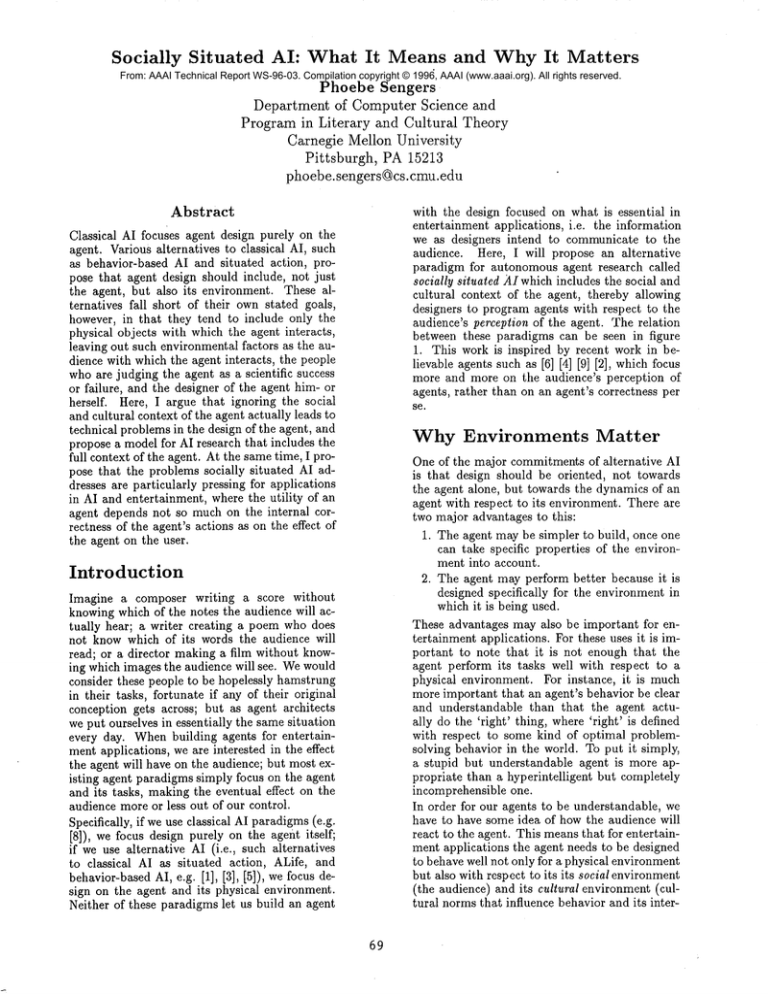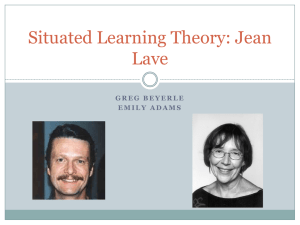
Socially
Situated
AI: What It Means and Why It Matters
From: AAAI Technical Report WS-96-03. Compilation copyright © 1996, AAAI (www.aaai.org). All rights reserved.
Phoebe
Sengers
Department of Computer Science and
Program in Literary
and Cultural
Theory
Carnegie Mellon University
Pittsburgh,
PA 15213
phoebe.sengers@cs.cmu.edu
with the design focused on what is essential in
entertainment applications, i.e. the information
we as designers intend to communicate to the
audience. Here, I will propose an alternative
paradigm for autonomous agent research called
socially situated AI which includes the social and
cultural context of the agent, thereby allowing
designers to program agents with respect to the
audience’s perception of the agent. The relation
between these paradigms can be seen in figure
1. This work is inspired by recent work in believable agents such as [6] [4] [9] [2], which focus
more and more on the audience’s perception of
agents, rather than on an agent’s correctness per
Abstract
Classical AI focuses agent design purely on the
agent. Various alternatives to classical AI, such
as behavior-based AI and situated action, propose that agent design should include, not just
the agent, but also its environment. These alternatives fall short of their own stated goals,
however, in that they tend to include only the
physical objects with which the agent interacts,
leaving out such environmental factors as the audience with which the agent interacts, the people
whoare judging the agent as a scientific success
or failure, and the designer of the agent him- or
herself. Here, I argue that ignoring the social
and cultural context of the agent actually leads to
technical problems in the design of the agent, and
propose a model for AI research that includes the
full context of the agent. At the same time, I propose that the problems socially situated AI addresses are particularly pressing for applications
in AI and entertainment, where the utility of an
agent depends not so much on the internal correctness of the agent’s actions as on the effect of
the agent on the user.
se.
Why Environments
Matter
One of the major commitments of alternative AI
is that design should be oriented, not towards
the agent alone, but towards the dynamics of an
agent with respect to its environment. There are
two major advantages to this:
1. The agent may be simpler to build, once one
can take specific properties of the environment into account.
2. The agent may perform better because it is
designed specifically for the environment in
which it is being used.
These advantages may also be important for entertainment applications. For these uses it is important to note that it is not enough that the
agent perform its tasks well with respect to a
physical environment. For instance, it is much
more important that an agent’s behavior be clear
and understandable than that the agent actually do the ’right’ thing, where ’right’ is defined
with respect to some kind of optimal problemsolving behavior in the world. To put it simply,
a stupid but understandable agent is more appropriate than a hyperintelligent but completely
incomprehensible one.
In order for our agents to be understandable, we
have to have some idea of how the audience will
react to the agent. This means that for entertainment applications the agent needs to be designed
to behave well not only for a physical environment
but also with respect to its its social environment
(the audience) and its cultural environment (cultural aorms that influence behavior and its inter-
Introduction
Imagine a composer writing a score without
knowingwhich of the notes the audience will actually hear; a writer creating a poem who does
not know which of its words the audience will
read; or a director making a film without knowing which images the audience will see. Wewould
consider these people to be hopelessly hamstrung
in their tasks, fortunate if any of their original
conception gets across; but as agent architects
we put ourselves in essentially the same situation
every day. Whenbuilding agents for entertainment applications, we are interested in the effect
the agent will have on the audience; but most existing agent paradigms simply focus on the agent
and its tasks, making the eventual effect on the
audience more or less out of our control.
Specifically, if we use classical AI paradigms(e.g.
[8]), we focus design purely on the agent itself;
if we use alternative AI (i.e., such alternatives
to classical AI as situated action, ALife, and
behavior-basedAI, e.g. [1], [3], [5]), we focus design on the agent and its physical environment.
Neither of these paradigms let us build an agent
69
ClassicalAI
Alternative
AI
SociallySituatedAI
Figure 1: Gradually including more of the agent’s context
pretation). To be appropriate for entertainment,
the agent needs to be reasonably comprehensible
to its audience and to communicate through its
behaviors the sorts of things the designer is trying
to get across.
Why Alternative
Enough
AI Is Not
Knowingwhat the audience finds understandable
and what sorts of things the agent communicates
to them is hard when the design of the agent focuses only on the agent itself, as in classical AI.
Alternative AI, on the other hand, seems perfect for such an approach because it puts a great
emphasis on the fact that an agent can only he
thought of in terms of an environment. However,
for alternativists the ’environment’ of an agent,
generally speaking, only includes its physical environment. Often, there are explicit attempts to
exclude the social and cultural environment of
the agent. Tim Smithers, for example, bewails
the fact that the very term ’agent’ has cultural
connotations. "The term ’agent’ is, of course, a
favourite of the folk psychological ontology. It
consequently carries with it notions of intentionality and purposefulness that we wish to avoid.
Here we use the term divested of such associated
baggage" [7]. The language Smithers uses reflects
a prevailing belief in AI that the social and cultural environment of the agent - unlike its physical environment - is simply so muchbaggage to
be discarded.
At first blush, this is a little strange. If the environment of the agent is so important in alternative AI, whyare big chunks of it being left out
of agent design altogether? I suspect that this is
related to the fact that alternative AI, especially
ALife, is often trying to model agents scientifically. Without thinking about it, researchers often fall into a modeI term ’naive objectivity’, in
which any mention of the social and cultural context is considered to taint the scientificity of the
resulting agent. Researchers end up artificially
Figure 2: Alternative AI excludes the full environment.
narrowing the context of the agent to exclude the
necessarily subjective parts of the environment,
i.e. the person who built the agent and the person judging it (see figure 2).
Leaving out the social context becomes problematic for entertainment applications, because in
these applications it is precisely the communication between the designer and the audience that
is important. Agent architectures that force you
to design the agent only with respect to its behaviors, and not with respect to how those behaviors are communicated to and understood by
the audience, are not giving you enough power to
programthe things that really count in entertainment applications.
Excluding the Full Context
Causes Confusion
Leaving out the full context is not just bad because you lose power. It actually may make it
harder to solve technical problems that come up
with the development of agents. This is because
simply ignoring the social and cultural context
does not make it go away. What ends up happening is that, by insisting that culturM influences are not at work, those influences come back
through the back door.
As an example, consider the use of symbolic pro7O
picture of what that agent is, without which
agents cannot be meaningfully judged.
2. An agent’s design should focus, not on the
agent itself,
but on the dynamics of that
agent with respect to its physical and social
environments. In classical AI, an agent is designed alone; in alternative AI, it is designed
for a physical environment; in socially situated AI, an agent is designed for a physical,
cultural, and social environment, which includes the designer of its architecture, the
creator of the agent, and the audience that
interacts with and judges the agent, including both the people who engage it and the
intellectual peers whojudge its epistemological status. The goals of all these people must
be explicitly taken into account in deciding
what kind of agent to build and how to build
it.
Artificial
3. An agent is a representation.
agents are a mirror of their creators’ understanding of what it means to be at once mechanical and human,intelligent, alive, a subject. Rather than being a pristine testingground for theories of mind, agents come
overcoded with cultural values, a rich crossroads where culture and technology intersect
and reveal their co-articulation.
gramming. Alternativists
often recognize that
symbolic programmingof the kind classical AI engages in is grounded in culture. Someof them believe that by abandoning symbolic programming
they, unlike classicists, have also abandonedthe
problem of cultural presuppositions creeping into
their work. And in fact it is true that manyalternative AI programs do use symbols sparingly,
if at all, in their internal representations.
Nevertheless, it wouldbe fair to say that the architecture of such agents involves symbols to the
extent that the engineer of the agent must think
of the world and agent in a symbolic way in order
to build the creature. For example, the creature
may have more or less continuous sensors of the
world, but each of those sensors may be interpreted in a way that yields, once again, symbols
- even when those symbols are not represented
explicitly in an agent’s program. The behaviors
the agent is split up into are also fundamentally
symbolic ("play fetch, .... sleep," "beg," etc.).
while alternative AI has gotten away from symbolic representations within the agent, it has not
gotten away from symbolic representations altogether. Once you look at the entire environment
of the agent, including its creator, it is clear that
despite the rhetoric that surrounds alternative AI
symbolsstill play a large role.
Leaving out the social context is both epistemologically inadequate and obfuscating. By not
looking at the subjective aspects of agent design,
the very nature of alternative AI programming,as
well as the origin of various technical problems,
becomes obscured. This is particularly problematic because not being able to see what causes
technical problems may make them hard, if not
impossible, to solve.
Socially
Situated
Socially Situated
Entertainment
AI for
All these abstract premises are well and good, but
what does this actually meanfor the design of autonomous agents? Currently, autonomous agents
built using the alternative AI approach are often
split up into behaviors. These behaviors are then
combined in order to allow the agent to achieve
various goals in the world. I propose that these
behaviors should be designed, not just in terms
of fulfilling the internal goals of the agent, but in
terms of what the agent is communicating to the
audience. Behaviors must be programmed with
enough observable actions that the audience for
which the work is designed will actually be able
to tell that the agent is engaged in that behavior.
This has a number of implications.
First of all, behaviors cannot be thought of purely
in terms of the agent’s goals, but must also be observable to the audience through external signs.
It is not enough to just do something; the audience must be able to tell the agent is doing it.
This means a behavior, generally speaking, includes the intention to communicate that behavior to the audience. ’Behaviors’ in this paradigm
therefore become something more like ’meaningful units of action’ than the a priori, universal
modes of behavior in most behavior-based AI applications.
Also, the behavior must be designed with a concrete audience in mind. For example, an ’insult-
AI Defined
What should alternative AI do instead? In this
section, I will lay out the basic premisesof socially
situated AI. In the next section, I will explain how
this can be applied to the problem of building autonomousagents for entertainment applications.
1. An agent can only be evaluated with respect
to its environment, which includes not only
the objects with which it interacts, but also
the creators and observers of the agent. Autonomousagents are not ’intelligent’ in and
of themselves, but rather with reference to a
particular system of constitution and evaluation, which includes the explicit and implicit
goals of the project creating it, the group
dynamics of that project, and the sources
of funding which both facilitate and circumscribe the directions in which the project can
be taken. An agent’s construction is not limited to the lines of code that form its program
but involves a whole social network, which
must be analyzed in order to get a complete
71
ing’ behavior maybe very different for a Japanese
than an American audience; ’macho’ behavior
may come across differently for a working class
or an academic audience. In general, behaviors
do not have meaning in and of themselves; they
take on a variety of meaningsin a variety of contexts. In order for the agent to be effective in
the context in which it is inserted, it is important that the designer consider this context when
building the agent.
Socially situated agents therefore incorporate the
same kinds of limitations and advantages for social environments as agents situated in a physical environment. Yes, they will only function
properly for the audience for which they were designed; on the other hand, in that context they
may be simpler to build and may perform better
precisely because they are designed specifically
for the environment in which they are being used.
for real-time virtual environments. In Proceedings of SIGGraph, 1995.
[3] RodneyBrooks. A robust layered control system for a mobile robot. IEEE Journal of
Robotics and Automation, RA-2:14-23, April
1986.
[4] Bryan A. Loyall and Joseph Bates. Hap: A reactive, adaptive architecture for agents. Technical Report CMU-CS-91-147, Carnegie Mellon University, 1991.
[5] Pattie Maes. Howto do the right thing. AI
Memo1180, MIT AI Laboratory,
December
1989.
[6] Scott Neal Reilly. Believable social and emotional agents. Forthcoming Ph.D. thesis.
Tim
Smithers. Taking eliminative material[7]
ism seriously: A methodology for autonomous
systems research. In Francisco J. Varela and
Paul Bourgine, editors, Towards a Practice
of Autonomous Systems: Proceedings of the
First European Conference on Artificial Life,
pages 31-47, Cambridge, MA, 1992. MIT
Press.
[8] Steven Vere and Timothy Bickmore. A basic
agent. Computational Intelligence, 6:41-60,
1990.
[9] Peter Wavish and Michael Graham. A situated action approach to implementing characters in computer games. AAI, 10, 1996.
Conclusion
Socially situated AI, while inspired by and an
outgrowth of alternative AI, ends up proposing
quite a different model of what it means to build
and be an agent. While alternative AI sees the
agent as existing in a cultural vacuum, socially
situated AI explicitly puts the agent in its larger
social context in order to make agents that can
function more effectively in practice. This means
agents are designed with communicable, rather
than a priori, behaviors; and that agents can be
designed for the specific contexts in which they
will function, rather than being hamstrung by
an impossible demandto be culturally universal.
Rather than "do the right thing", focusing on a
problem-solving approach, we want to "do the
thing right," behaving in a way that makes sense
to an audience. These changes are especially important for entertainment applications, where designers would like to be able to have reasonably
predictable effects on their audiences, rather than
taking the shot-in-the-dark approach necessitated
by agent architectures that cannot take the audience’s perceptions into account.
Acknowledgement
This work was done in the context of Joseph
Bates’s Oz Project. It was supported by the Office of Naval Research under grant N00014-92-J1298.
References
[1] Bruce Blumberg. Action-selection in hamsterdam: Lessons from ethology. In Proceedings of
the 3rd International Conference on the Simulation of Adaptive Behavior, Brighton, 1994.
[2] Bruce Blumberg and Tinsley A. Galyean.
Multi-level direction of autonomouscreatures
72


